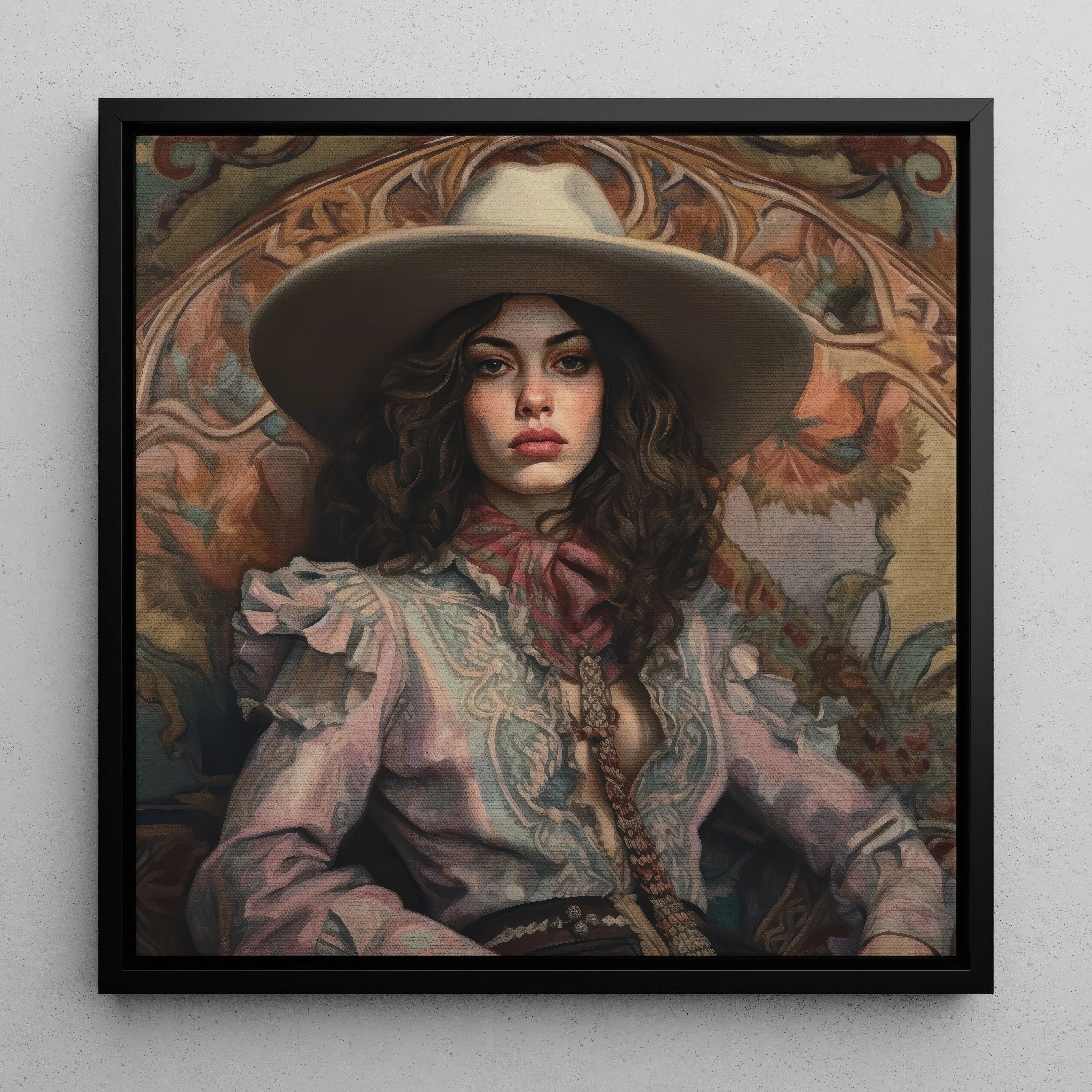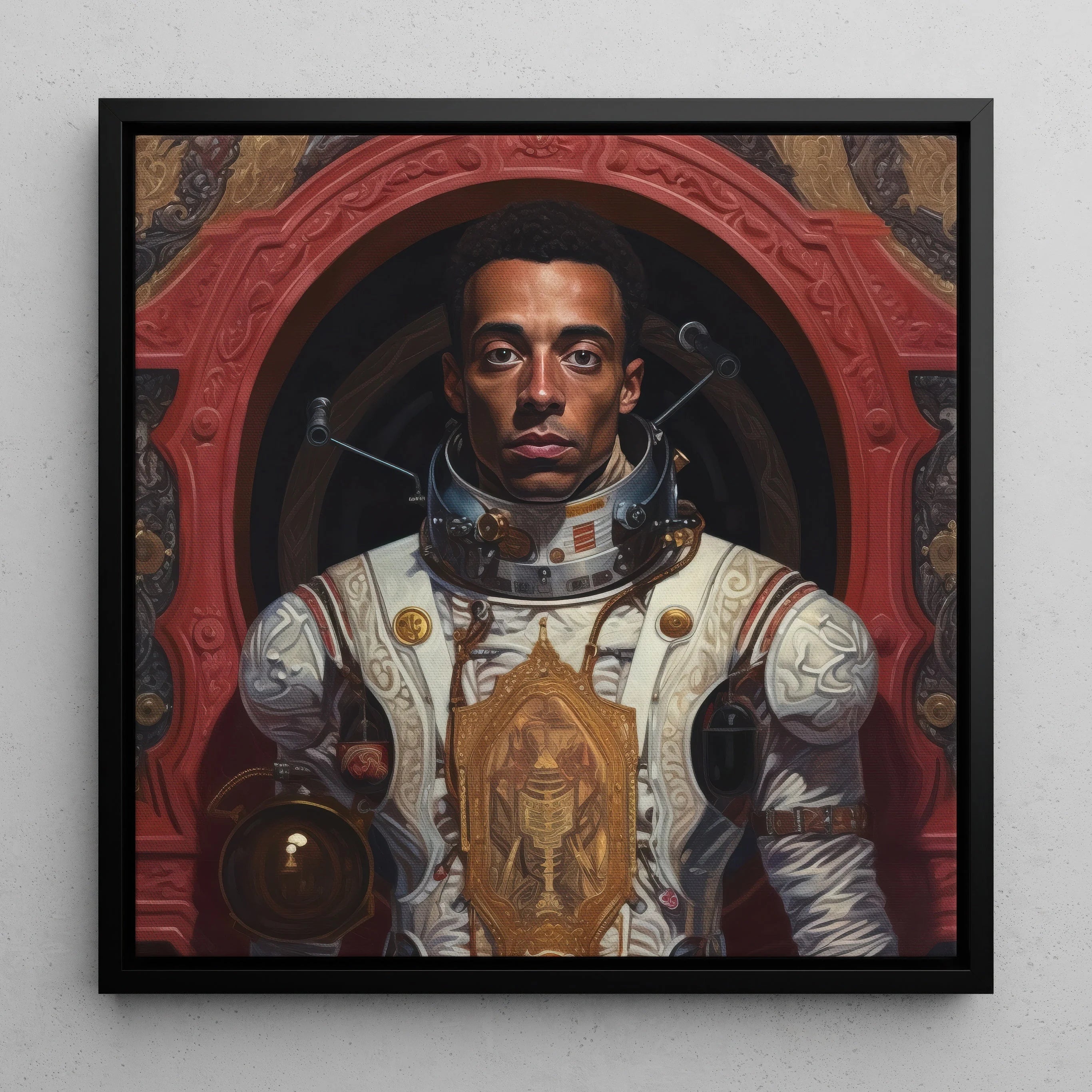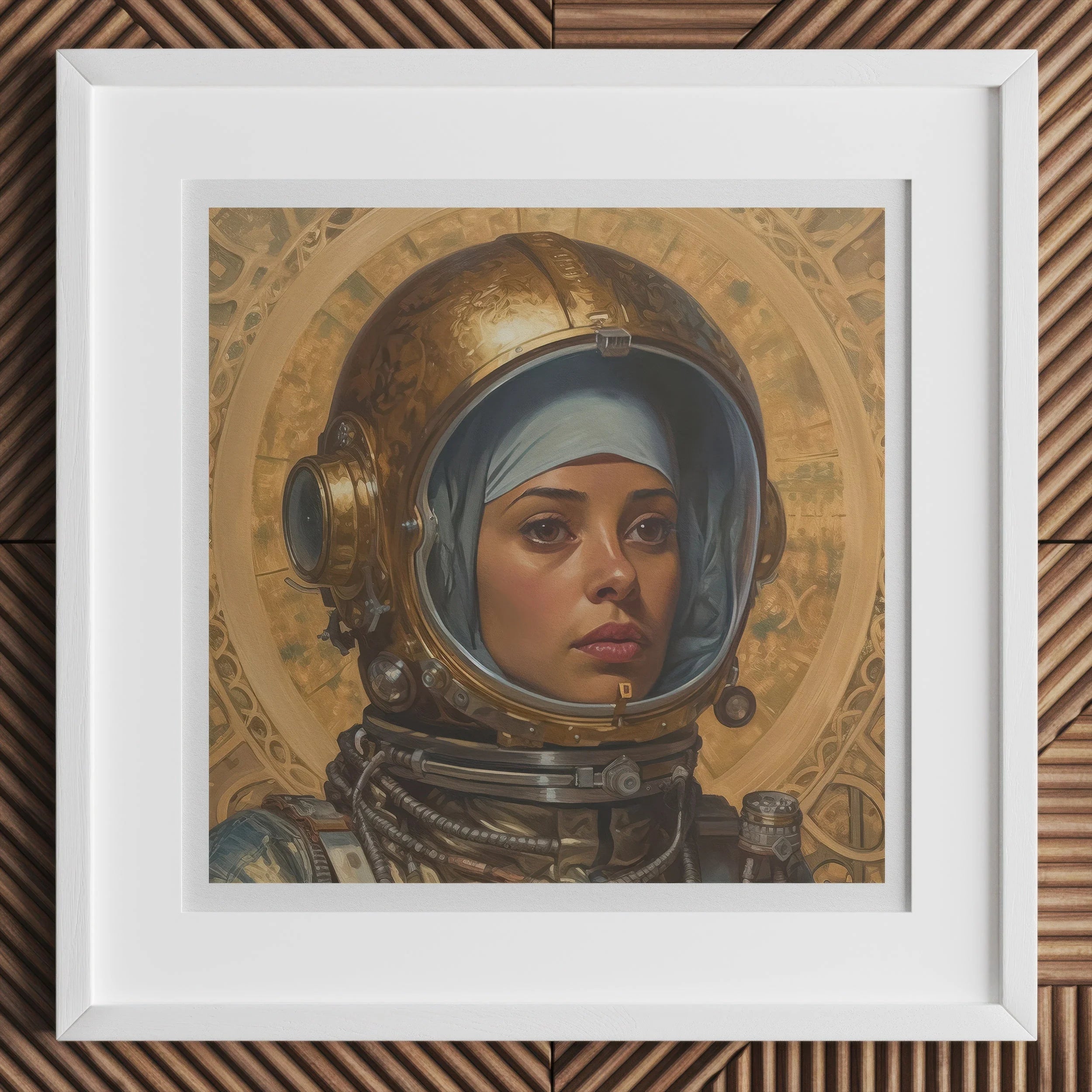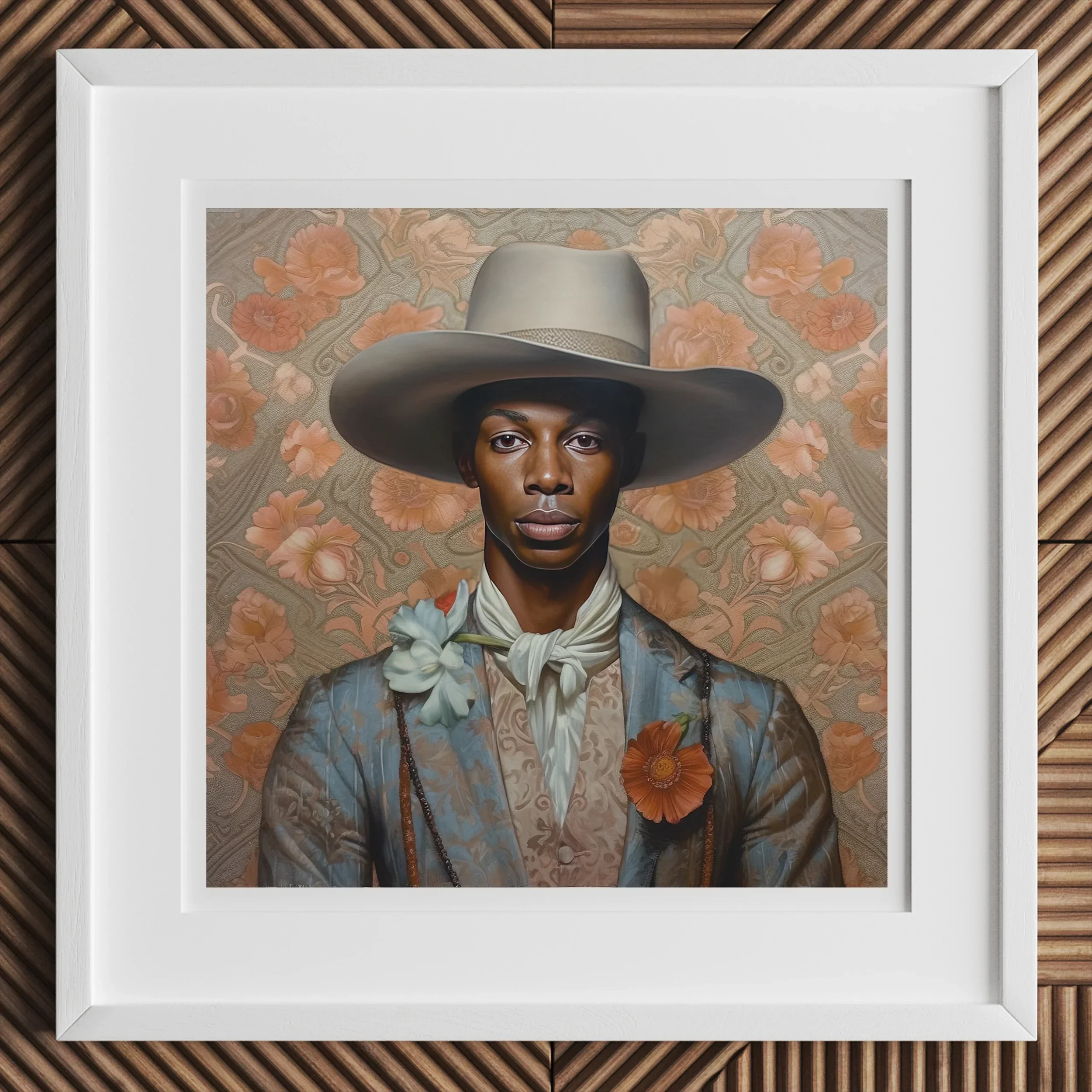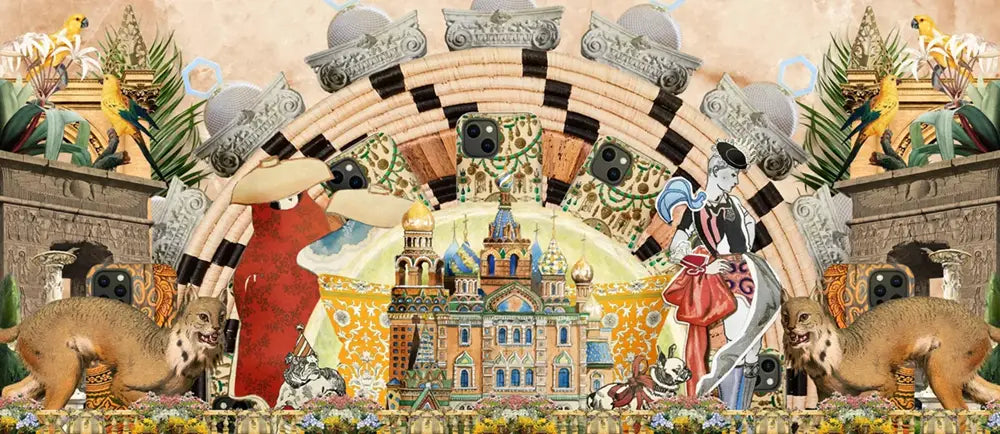We’ve all lived inside the hush of less. Those rooms where silence pools in corners, where a single chair becomes a sermon in restraint, where white walls impersonate wisdom. Minimalism taught us to edit our lives into haiku: sparse, clean, deliberately empty. It promised clarity through subtraction—until it didn’t.
Enter Maximalism, not as rebellion but as renaissance. It does not knock politely. It bursts in wearing chartreuse brocade, balancing a velvet lampshade on its head, and demands to be seen, touched, and felt in surround sound. It doesn’t ask “why so much?”—it asks, “Why not more?” It is a visual bacchanalia, a tactile rapture, a cacophony stitched into coherence by love of story and refusal of blandness.
Maximalism is not a mess—it’s curated orchestration. It gathers eclectic treasures, not as clutter, but as autobiography. It builds altar-like corners and layered compositions where every object carries memory, mischief, or myth. It’s a philosophy masquerading as décor. It stretches across centuries and disciplines—art, fashion, graphic design, interior decor—and in each domain, it sings the same refrain: complexity is a form of care. Pattern is a politics. Color is a claim to joy.
In this kaleidoscopic expedition, we will not merely chart Maximalism’s rise—we will inhabit its bloom. From the gilded splendor of the Baroque and Rococo, through the dense ornamentation of the Victorian Era, to its 20th-century reincarnation as a luminous antidote to austerity, Maximalism’s throughline is this: it is an emotional architecture. A sanctuary of too much. A chronicle of personal myth rendered in fabric, motif, and light.
Its modern resurgence isn’t nostalgia—it’s necessity. In a digital scroll-world of hyper-efficiency and algorithmic sameness, Maximalism becomes an analog ritual: a rebellion of texture, a return to sentiment, a theater of the tangible. We need the embroidered, the overgrown, the unexpected combinations. We need rooms that look like inside jokes, outfits that flirt with the absurd, paintings that don’t apologize for their riot of motifs.
Key Takeaways:
- Maximalism stands diametrically opposed to minimalism, championing excess, bold design elements, and layered complexity.
- This rich aesthetic surfaces in art, fashion, graphic design, interior decor, and beyond—challenging the notion that “less is more.”
- Adopting maximalist ideals often expands into one’s broader lifestyle, fusing creativity with everyday expression.
- I’m so immersed in the maximalist movement I’m referenced as a design expert on Redfin’s blog! Maximalist Interior Design in Small Spaces | Redfin
- Genesis of Abundance: Historical Trajectories of Maximalism
Genesis of Abundance: Historical Trajectories of Maximalism
Before Maximalism was a hashtag or moodboard aesthetic, it was a compulsion etched into our earliest architecture of display. Human beings have long flirted with excess—not as gluttony, but as language. In the courts of Baroque and Rococo Europe, extravagance became ideology. Ceilings wept frescoed heavens. Chandeliers hung like crystal ecosystems. Fabrics weren’t chosen; they were summoned like deities. Every gilded frame or carved balustrade whispered of divine right, conquest, wealth, and control.
But the heart of Maximalism beats deeper than royalty’s golden corridors. It flickers inside the humble intimacy of the Wunderkammer—those Renaissance “cabinets of curiosities” that gathered science, superstition, and spectacle under one roof. Here, curated chaos was not aesthetic—it was epistemological. Fossils, automata, gems, and antlers tumbled together not to please the eye but to ignite it. These rooms were symphonies of wonder. A proto-maximalist dreamscape built not for Instagram, but for awe.
This early fervor for collection—disparate yet meaningfully grouped—set the tone for all that would follow. Today’s cluttercore, your grandmother’s riotous sitting room, the exuberant gallery wall behind your Zoom calls—all of them echo this primal urge: to surround oneself with evidence of curiosity, joy, and contradiction.
Wunderkammer
Long before giant chandeliers and gilded corridors enraptured the nobility, there existed the Wunderkammer, or “cabinet of curiosities.” In Germany and other pockets of Renaissance Europe, wealthy collectors fashioned intimate sanctuaries brimming with exotic artifacts, scientific oddities, and artistic marvels. This was curated chaos at its nascent stage—a place to fuel conversation, spark intellectual discovery, and exhibit the broad tapestry of human knowledge.
In these proto-museums, visitors might stumble upon fossils, rare gemstones, astrolabes, or taxidermied creatures from half a world away. There was no single theme—only a fervent desire to gather and display the wonders of existence. Today’s cozy maximalism and even the whimsical mania of cluttercore trace genealogies back to this impulse: that heartfelt drive to envelop ourselves in objects that reflect both the vastness of our world and the particular paths we’ve walked.
Baroque and Rococo
Key characteristics: Opulence, grandiose ornamentation, gilded accents, sensuous curves, rich color harmonies
Influential factors: Royal patronage, symbolic displays of authority, flourishing arts
If the Wunderkammer was Maximalism in miniature, Baroque was its operatic sibling. The 17th century saw power expressed in embellishment: palatial interiors laced in gold leaf, painted allegories thundering across ceilings, and furniture that seemed half sculpture, half throne. Baroque ornamentation wasn’t frivolous; it was a strategic tool of propaganda. Splendor was currency. Excess equaled legitimacy.
Then came Rococo, which took this visual language and taught it to flirt. It lightened the palette—pastels instead of golds—and swapped out solemn angels for coquettish cherubs. C-shaped scrolls, floral arabesques, and gilded accents became the architectural equivalent of laughter: dazzling, opulent, yet tinged with intimacy. Rococo is often mistaken for softness. But beneath the blush and shell motifs lies a radical declaration—that grandeur could giggle.
Both styles, distinct yet intertwined, reveal a fundamental truth: Maximalism is often born where power meets performance. Whether in Versailles or a fashion editorial, it insists on visibility. It refuses the grey void of neutrality. It revels in rich color harmonies and sensuous curves, not as indulgence, but as signal.
The Victorian Era
Key characteristics: Layered textiles, jewel tones, dense ornamentation, mixing diverse styles, dark wood
Influential factors: Industrial Revolution, rising middle class, global goods, exploration
By the time Maximalism reached the 19th century, its locus had shifted—from throne rooms to parlor rooms. The Victorian Era democratized decoration. With the Industrial Revolution came mass production and an emerging middle class hungry for ornamentation once reserved for aristocrats. Houses became storybooks written in wallpaper, gaslight, and velvet.
The Victorian parlor was an immersive biography. Jewel tones, layered textiles, dense ornamentation—everything served a dual purpose: beauty and biography. An African cameo beside an Asian vase, a carved piano under a daguerreotype—these were not just style choices. They were declarations of identity, aspiration, and intellectual reach. Every object hinted at global awareness, domestic pride, or both.
To modern eyes, the Victorian aesthetic may seem overwrought. But its density was strategic. These interiors were social theaters, where furniture choreographed movement, and pattern signaled personality. It was Maximalism practiced not by decree, but by desire—a desire to be seen, known, and remembered through things.
The 20th Century
Key characteristics: Bold contrasts, reaction to modernist austerity, eclectic mixing, pops of post-war optimism
Influential factors: Economic growth, digital influences, social rebellion, desire for personal identity
Maximalism, like a favorite coat rediscovered in the attic, re-emerged in the 20th century as resistance. After decades of modernist austerity—where function reigned, lines sharpened, and “form follows function” became gospel—something had to give. That something was joy.
As minimalism came into full bloom, with its architectural purity and emotional restraint, Maximalism returned as the necessary shadow. Its war cry came from architect Robert Venturi, who responded to Mies van der Rohe’s ascetic “Less is more” with a phrase that now feels almost prophetic: “Less is a bore.”
Post-WWII economies, technological leaps, and a rising culture of individualism created fertile ground for visual abundance. From the Pop Art rebellion of the 1960s to the postmodern pastiche of the 1980s, Maximalism expressed not just decoration, but defiance. Against uniformity. Against the tyranny of beige.
The era birthed interiors soaked in color, art that exploded in pattern, and clothing that stitched together identities across time and genre. It reflected the mounting refusal to flatten the world into grids and greyscales. In every overloaded canvas and jewel-toned couch, Maximalism whispered the same revolutionary idea: life is not tidy—so why should style be?
Maximalism in the Visual Arts: A Celebration of Excess
Maximalist art is not a mural—it’s a maelstrom. A vertiginous plunge into layered iconographies, tangled textures, and chromatic excess that mocks the sanctimony of “less is more.” Where minimalism pares things down to their bones, Maximalism insists that the marrow has meaning too. It builds visual palimpsests out of desire, memory, and cultural reference—images thick with simultaneity, where the viewer must surrender to visual saturation as an act of recognition.
To stand before a maximalist artwork is to be engulfed—not just by pigment or pattern, but by narrative proliferation. You do not look at a maximalist painting; it looks back, with eyes composed of infinite motifs, brushstroke relics, embedded jokes, and half-remembered symbols. These compositions often reflect a spirit of horror vacui, that ancestral fear of the blank space—an artistic agoraphobia that fills every inch with something: shape, shadow, or metaphor. But behind this fullness lies no chaos—only complexity, cunningly arranged.
In maximalist visual art, clutter becomes choreography. The apparent “too-muchness” is structured like a fugue: themes recur, motifs overlap, contradictions cohabitate. Cultural detritus is repurposed as gospel. Comic strips, historical documents, graffiti, calligraphy, advertising logos, Renaissance figures—all collide, not as random juxtaposition, but as deliberate convolution. The art doesn’t ask to be understood in a single glance. It begs for prolonged witness. It demands a kind of devotional looking.
Maximalist artists use saturation as semiotics. They interrogate taste, identity, capitalism, trauma, joy—through excessive visual language. It is not an aesthetic of prettiness; it is an aesthetic of uncontainability.
Family Tree of Maximalist Art
The word “maximalism” itself first materialized in art criticism through Robert Pincus-Witten in the late 1970s. He observed a deviation—an eruption—from the clean economies of form that dominated modernist abstraction. In the Neo-expressionists like Julian Schnabel and David Salle, he saw a return to emotion, ornament, texture, and noise. These painters didn't just apply paint—they assaulted the canvas, embedding it with symbolic aggression, fragmented bodies, historical allusions, and the occasional broken plate. Their work wasn’t polite—it was personal.
But Pincus-Witten’s term only named what many artists had long practiced. One of Maximalism’s ancestral ghosts is Jackson Pollock, whose action paintings are less “works” and more events. His frenetic drips and flung skeins of paint create entropic galaxies—seemingly chaotic, but driven by compulsive intentionality. The canvas becomes not a window, but a choreographed surface of emotional velocity.
Then there is Yayoi Kusama, high priestess of infinity and repetition. Her Infinity Mirrored Rooms dissolve the borders of self, surrounding viewers in hallucinatory networks of light and polka-dotted obsessions. Here, pattern becomes prayer. Excess becomes trance. Her works are immersive maximalist chapels—simultaneously playful and unnerving—inviting the spectator to dissolve into multiplicity.
Gustav Klimt, ever the alchemist, fused sensual figuration with gold-leaf ornamentation, creating bodies cocooned in Byzantine ecstasy. His portraits shimmer with floral labyrinths and decorative opulence that seem almost animate. Every inch sparkles with erotic secrecy.
Jean-Michel Basquiat, by contrast, weaponized the maximalist instinct. His canvases are fierce, raw, and reverent all at once—graffiti layered over anatomical diagrams, crowned skulls, Latin phrases, and scribbled rage. His work is less about filling the space and more about carving it open—making visible the collisions of race, history, violence, and high/low culture that the art world preferred to ignore.
From these forebears springs a thriving garden of 21st-century maximalist voices. Artists like Jocelyn Hobbie conjure floral dreamscapes filled with surreal, lush femininity; Amir H. Fallah overlays portraiture with Persian patterns and veiled identities. Megan Williamson embraces thick brushwork and layered domestic spaces, while Ibrahim Mahama stitches together histories through discarded materials and industrial remnants.
Athene Galiciadis merges sculpture with rhythmic patterns drawn from rituals and nature. Alia Ali folds textile traditions into immersive installations that reflect on diaspora and power. Sarah Sullivan Sherrod plays with kitsch and craft, while Adelaide Cioni collapses folk forms into chromatic puzzles. Tunji Adeniyi-Jones renders the Black body as mythic icon, engulfed in rhythmic pattern and ceremonial repetition. Each of these contemporary artists treats surface not as finish, but as field—a battleground for identity, history, and desire.
What links these artists isn’t just visual overload—it’s the conceptual assertion that the world cannot be flattened. Their artworks reflect a postmodern subjectivity: layered, fragmented, overstimulated, contradictory. In an age of information saturation, Maximalism feels more accurate than abstraction. It captures the thrum of the scrolling mind, the associative leaps of memory, the simultaneity of the digital and the ancestral. Where minimalism seeks clarity, Maximalism captures the mess—and makes it meaningful.
Maximalism in Graphic Design
If minimalism in graphic design was the zen koan—restrained, balanced, obsessively hygienic—then Maximalism is the illuminated manuscript on acid. It doesn’t whisper brand values from a tight Helvetica grid. It howls them in ornate typography, saturated tones, and irreverent juxtapositions that would make Bauhaus blush.
In the past two decades, digital design veered hard toward uniformity. The ubiquity of sanitized apps, muted UI palettes, and soulless sans-serifs created an ecosystem where design was no longer a conversation—it was compliance. Everything had to “look clean,” “feel intuitive,” and most of all, “disappear.” But visual invisibility is not the same as usability. And for many designers, the tyranny of neutrality became unbearable.
Enter Maximalism, wielding lustrous serif fonts, textural interplay, and a refusal to obey the minimalist commandment of “empty space is sacred.” Here, white space is not worshipped—it is devoured, embroidered, painted over. Patterns collide with photography, ornamentation becomes centerpiece, and symmetry is abandoned for expressive cacophony. Maximalist graphic design doesn’t ask for attention. It demands it.
This revival isn’t just rebellion—it’s reinvention. The medium has changed. Our visual fields are now Instagram grids, phone screens, digital campaigns. In that compressed and crowded environment, minimalism often vanishes. Maximalism survives.
The movement owes much of its visual vocabulary and momentum to maverick designers who refused to make nice. Stefan Sagmeister, part jester, part provocateur, crafted branding and album covers that explode the notion of function-first. His work revels in the handmade, the idiosyncratic, the unexpected—a mouth stitched shut, a body used as canvas, typography carved into skin. Nothing is off limits.
Marian Bantjes has become the doyenne of decorative maximalism. Her signature style? Ornamental confectionery. She combines typographic finesse with filigree, floral patterns, and gold—embracing design as craft, not just communication. Her posters don’t just convey—they captivate.
David Carson, notorious for blowing up the rulebook, distorted text into visual jazz. His grunge-era editorial layouts for Ray Gun magazine made illegibility a kind of poetry. For Carson, to “break the grid” wasn’t metaphor—it was method.
And then there’s Paula Scher, who painted maps and identities in typographic floods. Her work for The Public Theater and Citibank showed how letterforms could shout, dance, and collide, creating motion within static print.
This maximalist renaissance in graphic design acknowledges a deeper truth: audiences are not algorithms. They’re humans—hungry for detail, storytelling, imperfection. A scrollable world craves friction, not silence. And in a visual culture obsessed with optimization, Maximalist design chooses exuberance instead.
Interior Worlds: The Principles and Practice of Maximalist Design
When Maximalism walks through the front door, it doesn’t remove its shoes. It arrives cloaked in velvet, trailed by a parade of antique lamps, framed portraits, lacquered animal figurines, and a Persian rug or six. But contrary to myth, it doesn’t seek to overwhelm—it seeks to orchestrate abundance. The goal is never chaos, but a carefully tuned polyphony of color, object, and texture where each element contributes to the room’s personality like a well-cast character in a sprawling narrative.
To live inside a maximalist interior is to occupy a space that feels alive—rooms that speak in layers, that reward close inspection with surprise, humor, intimacy. Here, every object performs. A ceramic dog might nod to your grandmother’s parlor. A Bauhaus side table might rub elbows with a French Empire chaise. These aren’t accidents—they’re declarations.
Maximalist interiors hinge on one principle above all: intention. The exuberance isn’t incidental; it’s editorial. Pattern, ornament, clutter—all are governed by invisible scaffolds of harmony, contrast, repetition, and mood. And unlike minimalist design, which often centers on erasure or neutralization, Maximalism thrives on the exaltation of personal history.
Layering and Textures
To enter a maximalist room is to feel your fingertips twitch. This is a world of touch as much as vision: velvet, silk, leather, brocade, each speaking its own dialect of sensuality. Rugs are stacked like geological strata. Curtains double up, with floral prints cresting over gauzy sheers. This is not haphazard excess. It’s a form of spatial intimacy—a design of seductive tactility where visual rhythm is set by the hand.
Eclectic Collections
No minimalist has ever had as much fun at a flea market as a maximalist. Objects with backstories—the thrifted ashtray, the Indonesian marionette, the Art Deco clock inherited from your great aunt—become the lived grammar of the room. These collections don’t match; they resonate. The goal is not symmetry, but conversation between objects, where eras and geographies collide, and something deeply personal emerges.
Bold Patterns and Colors
Maximalist interiors are chromatic feasts. Jewel tones rule the kingdom—emerald, sapphire, amethyst, garnet—punctuated by feverish clashes like fuchsia versus ochre or turquoise against tangerine. Patterns don’t whisper; they clash, flirt, echo. Wallpapers erupt in florals, geometrics, or tiger stripes. Upholstery spins tales in toile, ikat, and leopard. The effect? A kind of optical intoxication that resets the senses.
Overflowing Decor
The mantra “more is more” doesn’t mean “anything goes.” It means: be generous with meaning. A room might host three chandeliers, eight plants, twelve artworks, and a menagerie of objets d’art—but the magic is in how they balance. The eye must be led, not assaulted. Groupings—by color, height, theme—form tiny altars of coherence in the visual storm.
Personal Touches
Maximalism insists: you belong in this room. Not just your body, but your memories. A child’s drawing in a gilt frame. A Polaroid from a night you swore not to forget. A pressed flower, still fragrant with grief or celebration. These gestures anchor the aesthetic in autobiography. Without them, Maximalism becomes costume. With them, it becomes biographical theater.
Subtle Gilded Accents
Gleam is punctuation. A brass lamp, a gold-rimmed mirror, a bar cart that catches firelight just so—these metallic flickers stitch the room together. Gilded accents don’t demand a palace; they offer a wink to history, a nod to drama. They make rooms glow from within.
Contemporary Maximalist Interior Designers
Today’s maximalist magicians fuse the grand with the intimate, the classical with the eccentric. Their rooms are not backdrops—they’re character studies.
-
Kelly Wearstler, hailed as Maximalism’s reigning empress, builds interiors like Surrealist collages: abstract shapes, arresting color palettes, and spatial drama worthy of film sets.
-
Patrick Mele paints in pixels of pigment. His spaces vibrate with saturated hues, as though every wall were a personality in conversation with the next.
-
Melissa Rufty channels Southern charm into pattern-rich warmth, where heirlooms flirt with contemporary art.
-
Nick Olsen brings a wink to tradition. Think: Georgian symmetry interrupted by zebra-print ottomans and acid-green wallpaper.
-
Michelle Nussbaumer spins global histories into seamless spectacle—Turkish textiles, African masks, French antiques, all choreographed into kaleidoscopic balance.
-
Luke Edward Hall conjures worlds where Greco-Roman ghosts wear fuchsia capes and the 1980s never ended.
-
Malin Glemme electrifies Scandinavian restraint with a palette that shocks and seduces in equal measure.
-
Martina Mondadori Sartogo designs with the eye of a cultural anthropologist, layering storylines drawn from travel, heritage, and haute decor.
-
Stephen Alesch of Roman and Williams wields cinematic tension, blending old and new into rooms that seem to sigh with mood.
-
Dimore Studio time-travels between centuries, collaging eras into rooms that shimmer with temporal ambiguity.
-
Ken Fulk makes interiors that feel like baroque hallucinations: lush upholstery, riotous wallpaper, and an aesthetic that says, “Why not?”
These designers show us what Maximalism can become when wielded with humor, hunger, and a willingness to trust excess. Their work reminds us: design is not a doctrine—it’s a seduction.
Maximalist Design Concepts
Maximalism has never been monolithic—it splinters, spirals, spawns. In the social media age, its many faces are not merely archived but algorithmically amplified. Its visual children multiply daily in TikTok bedrooms and curated Instagram feeds, each version shimmering with its own aesthetic dialect, emotional logic, and stylistic extremity. But among these modern mutations, two micro-movements have taken root and bloomed with particular exuberance: dopamine decor and cluttercore.
Dopamine Decor doesn’t tiptoe into your home—it bursts in, technicolor grinning, with citrus-toned walls, banana-shaped mirrors, and paint-dripped coffee tables that look like they’re midway through a sugar high. This is Maximalism through the neurochemical lens: design that feeds the brain’s pleasure centers with saturated joy. There’s nothing neutral here—every color is dialed to eleven. Chartreuse meets bubblegum pink, and somewhere a velvet couch winks under a disco ball.
What sets dopamine decor apart isn’t just visual glee—it’s emotional intent. These interiors aim to uplift, to coax smiles from bad moods, to build rooms that feel like compliments. It’s design not just for display, but for delight. A neon sign that says “You’re doing amazing, sweetie” doesn’t feel ironic here—it feels like gospel. This is happiness as aesthetic strategy.
Cluttercore, by contrast, leans away from joy-as-aesthetic and into comfort as creed. Here, Maximalism takes on a domestic, lived-in warmth—less curated theater, more cozy avalanche. Books piled two deep. Candles half-burned. Trinkets clustered on mantels like old friends refusing to leave the party. It is not about precision. It is about presence.
Cluttercore reclaims the idea of mess. It elevates sentiment over symmetry. A hand-thrown mug, chipped but beloved. A childhood plush toy beside an ashtray from Prague. Here, the interior becomes a kind of emotional geology, where layers of memory and use accrete until the space feels like a body—slouchy, imperfect, but unmistakably yours.
Both trends thrive in the public theater of digital life. TikTokers stage maximalist nooks like altars to identity: layered bedding, tapestry-draped ceilings, walls dense with art and scribbles. Instagram’s scrollscape offers color-blocked rooms, floral explosions, ornament-rich corners that dazzle the eye and tell a story in a single frame. These are not trends for the camera-shy. They are styles that beg to be shared, reinterpreted, re-layered.
And yet, beneath the online spectacle lies something sincere: a yearning for intimacy, exuberance, and connection in a world often flattened by pixels and performance. Maximalism, in all its modern forms, offers a way back—to feeling, to clutter, to color, to complication as comfort.
Fashioning the Self: Maximalism as Personal Expression
Maximalism doesn’t stop at the walls—it spills into the closet, explodes across collars, ruffles through sleeves, and hangs chandelier-like from ears and wrists. In fashion, it is not a trend but a proclamation: an insistence that clothing is not just function or form, but theater, autobiography, and protest. It rejects understatement. It shreds normcore. It dresses like no one is watching—except they are, and that’s the point.
A maximalist ensemble is an ecosystem of intention. A sequined jacket doesn’t just sparkle—it shouts in Morse code. A blouse embroidered with rosettes paired with zebra-print trousers and combat boots is not chaos. It’s syntax in color and texture, a coded language of the self. Every accessory, every clash, is a sentence fragment in a visual diary that says: this is who I am today—complex, contradictory, and unafraid.
Maximalist fashion draws on art history, global craft, subcultural flair, and a museum’s worth of reference points. It’s not afraid to be baroque, futuristic, punk, camp, or surreal—often all at once. And unlike its minimalist sibling, which often traffics in the smooth polish of timelessness, Maximalist dress loves the dated, the decadent, the overdone. It loves drama and deliberate incongruity.
Key Characteristics
-
Bold Colors & Prints: Pair electric violet with mustard, or leopard with gingham, and let the collision sing. Nothing matches, but everything sparks. Maximalism builds harmony through shock.
-
Exaggerated Silhouettes: Balloon sleeves, voluminous skirts, architectural collars—shapes that command space and remake the outline of the body into a wearable sculpture.
-
Dramatic Embellishments: Sequins, fringe, metallic embroidery, beading—the more the better. These flourishes don’t decorate; they declare.
-
Layering & Textures: A patchwork coat over tulle, a mesh bodysuit beneath a tailored waistcoat, leather with lace, satin with wool. Each combination tells a story through collision and contrast.
-
Statement Accessories: Think earrings like chandeliers, rings the size of saucers, handbags shaped like cats, clocks, or fruit. These are objects with attitude—visual punctuation.
-
Mixing Eras & Styles: A 1970s jumpsuit under a Victorian bolero, finished with sneakers from a 2025 drop. Time folds into fabric. Past and future make eye contact.
Maximalist fashion doesn’t whisper identity—it amplifies it, letting the body become billboard, archive, and altar. It resists aesthetic obedience and replaces it with sartorial play. And at its heart is a belief that style is a verb, not a noun.
Influential Figures
Designers and icons alike have embraced this visual cacophony, each turning fashion into a dialect of joy, excess, and rebellion.
Gucci, under the vision of Alessandro Michele, became a temple of Maximalism—mashing ecclesiastical tailoring with nerd-core whimsy, vintage silhouettes, and gender-unraveling silhouettes. Valentino gleamed with baroque romanticism. Dolce & Gabbana spun Sicilian storytelling into gilded, embroidered fantasy. Balenciaga fractured silhouettes and context, turning irony into a couture weapon.
But Maximalism is not just runway—it is personal mythology. Zandra Rhodes made day-glo couture into art history. Leigh Bowery weaponized excess, costuming himself as performance art incarnate, blending club culture with grotesque glamour. Iris Apfel, ever the oracle of oversize glasses and antique jewelry, redefined aging as riotous style. Anna Dello Russo lives like a fashion editorial come to life—every look a pageant of boldness, audacity, and fun.
In their hands—and wardrobes—Maximalism becomes a daily practice of authorship, a refusal to dim, a reminder that to dress flamboyantly is often to dress truthfully.
Cultural Resonance: Maximalism in the Modern Context
Maximalism’s recent resurgence isn’t just an aesthetic ripple—it’s a cultural signal flare. In a world spinning with paradox—simultaneously hyper-connected and emotionally flattened—Maximalism re-emerges as a visual philosophy of plenty, not just in stuff, but in meaning. Its patterns, excesses, and irreverent layers are not just design choices. They are a refusal: to simplify, to conform, to disappear.
At the core of this revival sits postmodernism, that glorious deconstructor of binaries, hierarchies, and the myth of purity. Postmodernism delights in juxtaposition, embracing contradiction as fertile ground. Maximalism, its aesthetic offspring, does the same—but with sequins, baroque frames, anime figurines, and leopard print. It collages culture, folding Renaissance references into street art, Victorian wallpaper into digital collage, haute couture into thrift-store glamour. “High” and “low” become moot distinctions in a space where The Simpsons can sit beside Shakespeare—both framed, both gold-leafed.
This aesthetic slippage is political. Maximalism invites marginalized voices, hybrid identities, diasporic aesthetics, and non-Western traditions into the frame. It champions the polyphonic over the monolithic. It says: here is a world that refuses to be narrowed, flattened, or categorized. And it asks: who gets to define good taste anyway?
But design is not made in a vacuum. Every riot of color, every overstuffed bookshelf or mirrored hallway, arises in dialogue with social and economic conditions. Historically, periods of scarcity have been followed by bursts of abundance—not just in consumption, but in ornamentation. After wartime rations came the roaring, ruffled 1920s. After the grey grip of postwar modernism came the wild collages of the 1980s. These cycles are not frivolous—they are a kind of social exhalation.
Today’s Maximalism arises in a moment marked by fragmentation and hyper-reality. We scroll through a thousand aesthetics a day, toggling between mid-century modern, cyberpunk futurism, and cottagecore whimsy—sometimes within a single post. This cultural overload has a shape, and Maximalism is its architect.
Social Fabrication
The endless stream of imagery—TikTok rooms layered in wall art, Instagram shelves curated like traveling museums—reflects our hunger not just to consume, but to compose our lives as narratives. Digital tools allow us to amplify the maximalist impulse, staging scenes that double as self-portraits. The more saturated, the better. In a feed-driven economy, Maximalism isn’t excess—it’s legibility.
Tech Abundance
Technology hasn’t just spread Maximalism—it’s empowered it. With advanced printing, image editing, 3D rendering, and algorithmically targeted design inspiration, the once-costly look of opulence is now infinitely reproducible. That velvet wallpaper you dreamed of? A swipe away. That pop-art cabinet with Art Nouveau legs? Delivered next Tuesday. Digital platforms collapse the distance between dream and décor.
In this loop of hyperaccess and hyper-expression, Maximalism feels less like a trend and more like a psychic survival strategy. A way to declare: I am here. I contain multitudes. I choose color over erasure.
Minimalism vs Maximalism
Minimalism and Maximalism are not just design ideologies—they are philosophical weather systems, polar climates of space, spirit, and self. Minimalism strips the world bare to reveal a kind of moral clarity. It whispers peace through negative space, white walls, and honed materials. Maximalism replies, not with disagreement, but with a laugh, a chandelier, and an embroidered cushion that once belonged to your great-aunt's neighbor's cousin.
Minimalism, at its best, is a balm—discipline as sanctuary. It sharpens perception. In its presence, light becomes sacred, and silence a virtue. Its aesthetic grammar is one of omission: fewer lines, fewer colors, fewer things. It promises that through reduction, truth emerges.
But Maximalism says: truth is rarely so clean.
Maximalism doesn't just allow contradiction—it exalts it. It’s not afraid of visual noise, or of the untamed associations that come from layering memory atop desire atop kitsch. Where Minimalism seeks to quiet the room, Maximalism wants to hear it sing in polyphony. Pattern over pattern, object beside oddity, color fighting color—this is the language of a life fully confessed.
Their interplay forms a cultural pendulum. When a generation tires of sparseness, it flocks to abundance. When the eye aches from overstimulation, it craves stillness. The dialogue between these poles is eternal, cyclical, necessary.
But today, Maximalism’s surge seems less like a backlash and more like a correction. The world is not blank. It is buzzing, bursting, blurred. In this context, a home that mimics a gallery or a fashion choice that reads like autobiography feels more honest than a void polished to perfection.
Minimalism offers asceticism. Maximalism offers hospitality. And perhaps, in an age so data-choked and fragmented, it is Maximalism’s visual warmth, cultural hybridity, and emotional density that makes space for meaning.
Curated Chaos: Navigating the Fine Line of Maximalist Aesthetics
Maximalism walks a tightrope in brocade slippers. Its beauty lies not in abandon, but in orchestration. Yet for all its lushness, even the most ardent advocates must admit: one step too far, and the spell breaks. The baroque becomes burdensome. The exuberance tips into suffocation. A room meant to express personality begins to feel like a storage unit in drag.
Critics often dismiss Maximalism as indulgent clutter—a decorative tantrum with no off-switch. And they’re not wrong to worry. Without intention, Maximalist spaces can drown in their own decoration. Color schemes fray. Proportions warp. Emotional resonance is replaced with visual fatigue. The result? A space that feels more like a ransom note than a narrative.
“One of the biggest concerns with maximalism is that it can be overwhelming, with an abundance of busy patterns that make it cluttered and chaotic.” The danger is not abundance itself—it’s abundance without rhythm.
But successful Maximalism is never accidental. Behind the apparent anarchy, there’s always design intelligence at play. A maximalist room might include a dozen motifs, but they’ll echo one another. Shapes recur. Colors anchor. The eye travels across surface and object not as a flâneur in disarray but as a reader following a well-plotted novel. This is not pile-on. This is storytelling.
A Harmony of Excess
-
Intentionality: The maximalist home or artwork begins with clarity of purpose. Each item is there to provoke memory, signal affinity, or establish mood. Nothing is filler. Every frame, vase, or knickknack is part of a choreography of presence.
-
Balance & Scale: A towering palm tree balances a dense gallery wall. A velvet divan absorbs the visual sting of patterned wallpaper. Prints are mixed, yes—but the scale is varied, and the distribution is musical. There are crescendos and rests.
-
Personal Meaning: This isn’t shopping spree accumulation. It’s biographical curation. A collection of ceramic cats might be absurd in theory, but in the right corner, flanked by a portrait of your grandmother and a handwritten letter from a lost friend, it becomes an altar to memory.
-
Purposeful Layering: The goal isn’t to overwhelm—it’s to seduce slowly. Each layer builds on the last, adding not weight, but density. A floral print may match the curtains, which echoes a motif in a rug, which links to a figurine’s enamel glaze. It’s visual call and response.
When executed with vision, Maximalism is not clutter. It’s a symphonic argument for emotion, intimacy, and abundance. It gives form to nostalgia, architecture to identity, and aesthetic permission to embrace our contradictions.
Embracing Richness — Maximalism's Enduring Appeal
Maximalism is not a trend—it is a temperament. A worldview dressed in texture, contradiction, and unapologetic volume. It refuses the linear, the monochrome, the silent. In a world that constantly urges us to scale down, clear out, and fade into neutral, Maximalism insists: add more color, more context, more soul.
It’s a philosophy born not just from abundance, but from a deep, human craving to be seen in full. In every embroidered pillow, gilded frame, or multi-patterned jacket, Maximalism articulates something profound: identity is layered. Meaning resides in accumulation. And the stories we tell with our things are no less valid than those we write in books or post online.
From the sacred opulence of Baroque palaces to the layered parlors of the Victorian middle class, from Neo-expressionist canvases to today’s dopamine-drenched apartments on TikTok, Maximalism has been our visual language of self-mythology. It rises each time austerity flattens us. It answers cultural constraint with aesthetic wildness. It reclaims excess as emotional necessity.
In today’s digitized, decontextualized existence—where images arrive faster than thoughts, and content disappears before it’s digested—Maximalism offers grounding. A kind of spatial permanence. It invites us to surround ourselves with memory, history, and desire made visible. It gives shape to longing. It lets your favorite mug, your father’s ashtray, the Afghan throw from your honeymoon, the vintage Barbie, and the handmade quilt from a stranger on Etsy coexist like chapters in a visual autobiography.
And this is perhaps the secret of its appeal. Maximalism is personal. Fiercely, unashamedly personal. It resists optimization. It does not flatten. It is the antithesis of the one-size-fits-all lifestyle. It says: Your world should look like you. It should be too much, too strange, too sentimental, too specific.
Whether you're hanging mirrors above mirrors, or pairing rococo wallpaper with Bauhaus chairs, Maximalism gives permission to blur lines, mix eras, and prioritize emotion over expectation. It shows that joy can be spatial. That rooms, like outfits, can carry mischief, memory, and magic.
In the end, Maximalism is a kind of visual generosity. It assumes you will want to look closer. It rewards attention. It thrives on contradictions—discipline and drama, humor and heritage, kitsch and craftsmanship. It’s a home for the in-between.
And in that sense, Maximalism is not just an aesthetic—it is an ethics. A way of saying yes to the mess of living, to the full inventory of your experiences, to the beauty of both/and rather than either/or.
To live maximally is to accept that not everything needs to be justified, neutralized, or edited down. That meaning often exists in the overgrown places, between a disco ball and a taxidermy squirrel, between inherited lace and neon plastic. It’s to treat your home, your wardrobe, your artwork not as a design problem—but as a living archive of who you are.
In this age of algorithmic taste and minimalist branding, choosing Maximalism might just be an act of resistance.
Or better yet—an act of radical self-recognition.
Reading List
Awad, Ismail Ahmed, Diaa Tantawy, and Nagwa Mohamed Hamdy. 2021. “Interior Design between Minimalism and Maximalism’.” International Design Journal 11 (1): 303–7. https://doi.org/10.21608/idj.2021.133006.
“Baroque.” Wikipedia. Wikimedia Foundation. Accessed February 16, 2025.(https://en.wikipedia.org/wiki/Baroque).
Coelho, LL. 2023. “Maximalist Art Movement.” Know Thy Art. October 6, 2023. https://knowthyart.com/maximalist-art-movement/.
“Contemporary Maximalist Artists.” Google Search. Google.com. Accessed February 16, 2025. https://www.google.com/search?q=contemporary+maximalist+artists.
“Discover Maximalism: Exploring the Bold and Diverse Art Movement.” 2024. Adorno Design. November 21, 2024. https://adorno.design/editorial/discover-maximalism-exploring-the-bold-and-diverse-art-movement/.
“Exploring Artistic Extremes.” 2024. Cosimo.art. December 19, 2024. https://cosimo.art/blog/exploring-artistic-extremes/.
Gravley Witkowski, Amy. n.d. “Make the Most of Maximalism.” Columns / Creativity. Communication Arts. Accessed February 16, 2025. https://www.commarts.com/columns/make-the-most-of-maximalism.
Gupta, Krishna, and Dr. Deepti Pande Rana. 2024. “Minimalism Vs Maximalism: A Study of Contrasting Interior Design Style.” International Journal of Landscape Planning and Architecture 10 (01). https://journalspub.com/publication/ijlpa/article=6634.
“Here’s How Maximalism Is Shaping the High Fashion Industry.” n.d. Ellie Belle. Accessed February 16, 2025. https://elliebelle.com/blogs/news/heres-how-maximalism-is-shaping-the-high-fashion-industry.
“Maximalist Art Posters.” n.d. Art.com. Accessed February 16, 2025. https://www.art.com/gallery/id--b39168/maximalist-art-posters.htm.
“Maximalist Artists.” n.d. Masterworks Fine Art Gallery. Accessed February 16, 2025. https://www.masterworksfineart.com/artists/?genre=maximalist.
“Maximalist Interior Design.” n.d. Paper Moon Painting. Accessed February 16, 2025. https://papermoonpainting.com/maximalist-interior-design/.
“Maximalist Interiors: Top 5 Designers Secrets.” n.d. Hommés Studio. Accessed February 16, 2025. https://hommes.studio/journal/maximalist-interiors-top-5-designers-secrets/.
“Maximalism.” 2025. AESDES. January 22, 2025. https://www.aesdes.org/2025/01/22/maximalism/.
“Maximalism.” Wikipedia. Wikimedia Foundation. Accessed February 16, 2025. https://en.wikipedia.org/wiki/Maximalism.
“Maximalism: An Art of the Minor.” n.d. EliScholar - Yale University. Accessed February 16, 2025. https://elischolar.library.yale.edu/gsas_dissertations/1264.
Matoso, Marília. 2023. “Maximalism: What It Is and Why You Need to Know It.” ArchDaily. September 26, 2023. https://www.archdaily.com/1007027/maximalism-what-it-is-and-why-you-need-to-know-it.
“Meet the Maximalists: 5 Designers Who Think More Is More.” n.d. The Spaces. Accessed February 16, 2025. https://thespaces.com/new-maximalists-meet-five-designers-think-more-is-more/.
“Modern Art Prints & Maximalist Art.” n.d. Rambler Roam Co. Accessed February 16, 2025. https://rambleroamco.com/collections/modern-art-prints-maximalist-art.
“Pop of Modern Maximalist Interior Design | Emily June Designs.” n.d. Emily June Designs. Accessed February 16, 2025. https://www.emilyjunedesigns.com/pop.
“Rococo Aesthetic.” 2025. AESDES. January 22, 2025. https://www.aesdes.org/2025/01/22/rococo-aesthetic/.
“The Beauty of Maximalism: Its Roots and Its Significance in the Present Day.” 2025. The Science Survey. February 12, 2025. https://thesciencesurvey.com/arts-entertainment/2025/02/12/the-beauty-of-maximalism-its-roots-and-its-significance-in-the-present-day/.
“The Dichotomy of Design: Minimalism vs. Maximalism.” n.d. Speak Agency. Accessed February 16, 2025. https://www.speakagency.com/the-dichotomy-of-design-minimalism-vs-maximalism.
“The Maximalist Movement.” n.d. Decorative Materials. Accessed February 16, 2025. https://blog.decorativematerials.com/the-maximalist-movement.
“The Rise of Maximalism.” n.d. Vocast. Accessed February 16, 2025. https://vocast.com/the-rise-of-maximalism.
“Victorian Interior Design 101: Everything You Need to Know.” n.d. Purlfrost. Accessed February 16, 2025. https://www.purlfrost.com/blog/victorian-interior-design-101-everything-need-know/.
Woods & Warner. 2024. “Maximalism vs Minimalism.” Woods and Warner. September 6, 2024. https://www.woodsandwarner.com.au/2024/09/06/maximalism-vs-minimalism/.
...
Main image: Bedroom interior. Designed by 02A Studio. Photo by Serena Ellar.







